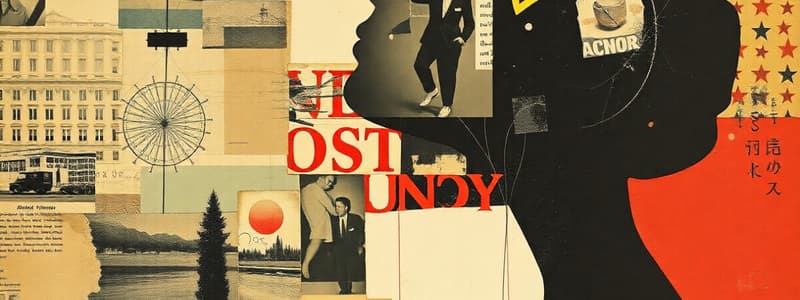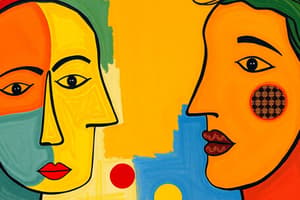Podcast
Questions and Answers
What aspect of Filipino culture is highlighted through friendships?
What aspect of Filipino culture is highlighted through friendships?
- Friendships are based solely on economic transactions.
- Friendships do not influence social alliances.
- Friendships are strictly formal and do not involve personal feelings.
- Friendships often carry the same status as family relationships. (correct)
What does 'utang na loob' signify in Filipino culture?
What does 'utang na loob' signify in Filipino culture?
- A permanent debt that can never be repaid.
- A privilege granted without expectation of return.
- An informal relationship devoid of commitments.
- A sense of obligation to repay favors received. (correct)
What is the concept of 'pakikisama' in Filipino culture?
What is the concept of 'pakikisama' in Filipino culture?
- An approach that emphasizes competition between friends.
- A practice of prioritizing individual success over group interests.
- A concept that discourages group activities.
- A focus on maintaining group harmony and cooperation. (correct)
How does the 'patron-client relationship' function in Filipino society?
How does the 'patron-client relationship' function in Filipino society?
What benefit of social relationships is associated with improved health?
What benefit of social relationships is associated with improved health?
What does inherited status refer to?
What does inherited status refer to?
Which leadership style is characterized by a mutual relationship between leaders and followers?
Which leadership style is characterized by a mutual relationship between leaders and followers?
Which quality is NOT essential for an effective leader?
Which quality is NOT essential for an effective leader?
Which component of emotion involves physiological changes like a racing heart?
Which component of emotion involves physiological changes like a racing heart?
What is the primary objective of social institutions?
What is the primary objective of social institutions?
What does the cognitive component of emotion primarily evaluate?
What does the cognitive component of emotion primarily evaluate?
In which leadership style do leaders and members exchange efforts for mutual rewards?
In which leadership style do leaders and members exchange efforts for mutual rewards?
Patty's trembling and deep breathing after the lamppost went out exemplifies which component of emotion?
Patty's trembling and deep breathing after the lamppost went out exemplifies which component of emotion?
Which statement best describes the behavioral component of emotion?
Which statement best describes the behavioral component of emotion?
Which of the following best describes adaptive and goal-seeking leaders?
Which of the following best describes adaptive and goal-seeking leaders?
Which of the following is a characteristic of followership?
Which of the following is a characteristic of followership?
In the James-Lange theory of emotion, what is the initial step in experiencing an emotion?
In the James-Lange theory of emotion, what is the initial step in experiencing an emotion?
What is the primary cognitive appraisal made when exam results exceed expectations?
What is the primary cognitive appraisal made when exam results exceed expectations?
Which leadership style promotes legitimate influence rather than power?
Which leadership style promotes legitimate influence rather than power?
What type of feeling is described as basic and may include responses like 'fear'?
What type of feeling is described as basic and may include responses like 'fear'?
Which term describes a person's position or rank within a community or group?
Which term describes a person's position or rank within a community or group?
What would be an example of the behavioral expression of an emotion?
What would be an example of the behavioral expression of an emotion?
What emotional response is commonly felt after achieving unexpectedly good exam results?
What emotional response is commonly felt after achieving unexpectedly good exam results?
What does the term 'emotion' etymologically mean?
What does the term 'emotion' etymologically mean?
How is social structure defined in this context?
How is social structure defined in this context?
Which of the following best describes vertical structure?
Which of the following best describes vertical structure?
What is an example of a role associated with status?
What is an example of a role associated with status?
Which aspect best characterizes a community in this context?
Which aspect best characterizes a community in this context?
What type of social structure is concerned with relationships among social groups?
What type of social structure is concerned with relationships among social groups?
What does the Schachter-Singer theory propose as the basis for emotional experiences?
What does the Schachter-Singer theory propose as the basis for emotional experiences?
According to the Cannon-Bard theory, how do emotional responses and physiological changes relate to each other?
According to the Cannon-Bard theory, how do emotional responses and physiological changes relate to each other?
In the context of fear and excitement, how does cognitive appraisal influence emotion according to the Schachter-Singer theory?
In the context of fear and excitement, how does cognitive appraisal influence emotion according to the Schachter-Singer theory?
What characterizes the Lazarus theory of emotion?
What characterizes the Lazarus theory of emotion?
What is the initial step in the emotional response process according to the James-Lange theory?
What is the initial step in the emotional response process according to the James-Lange theory?
Which situation best illustrates the application of the Cannon-Bard theory?
Which situation best illustrates the application of the Cannon-Bard theory?
In the context of walking in a dark alley, which of the following exemplifies the Schachter-Singer theory?
In the context of walking in a dark alley, which of the following exemplifies the Schachter-Singer theory?
How does the physiological response manifest in both fear and excitement according to the two-factor theory?
How does the physiological response manifest in both fear and excitement according to the two-factor theory?
Flashcards
Emotion
Emotion
A feeling or affect, ranging from basic fear to complex nostalgia, rooted in French and Latin.
Physical Component of Emotion
Physical Component of Emotion
The physiological changes that accompany an emotion.
Cognitive Component of Emotion
Cognitive Component of Emotion
The evaluation, interpretation, and identification of an emotion.
Behavioral Component of Emotion
Behavioral Component of Emotion
Signup and view all the flashcards
James-Lange Theory
James-Lange Theory
Signup and view all the flashcards
Physiological Change
Physiological Change
Signup and view all the flashcards
Emotional Evaluation
Emotional Evaluation
Signup and view all the flashcards
Emotional Expression
Emotional Expression
Signup and view all the flashcards
Cannon-Bard Theory
Cannon-Bard Theory
Signup and view all the flashcards
Schachter-Singer Theory (Two-Factor Theory)
Schachter-Singer Theory (Two-Factor Theory)
Signup and view all the flashcards
Lazarus Theory
Lazarus Theory
Signup and view all the flashcards
Physiological arousal
Physiological arousal
Signup and view all the flashcards
Cognitive appraisal
Cognitive appraisal
Signup and view all the flashcards
Stimulus
Stimulus
Signup and view all the flashcards
Social Structure
Social Structure
Signup and view all the flashcards
Horizontal Structure
Horizontal Structure
Signup and view all the flashcards
Vertical Structure
Vertical Structure
Signup and view all the flashcards
Community
Community
Signup and view all the flashcards
Society
Society
Signup and view all the flashcards
Status
Status
Signup and view all the flashcards
Role
Role
Signup and view all the flashcards
What is the difference between status and role?
What is the difference between status and role?
Signup and view all the flashcards
Social Institutions
Social Institutions
Signup and view all the flashcards
Leadership
Leadership
Signup and view all the flashcards
Reciprocal Leadership
Reciprocal Leadership
Signup and view all the flashcards
Transactional Leadership
Transactional Leadership
Signup and view all the flashcards
Transformational Leadership
Transformational Leadership
Signup and view all the flashcards
Cooperative Leadership
Cooperative Leadership
Signup and view all the flashcards
Adaptive and Goal-Seeking Leadership
Adaptive and Goal-Seeking Leadership
Signup and view all the flashcards
Followership
Followership
Signup and view all the flashcards
Real Kinship
Real Kinship
Signup and view all the flashcards
Ritual Kinship
Ritual Kinship
Signup and view all the flashcards
Utang na Loob
Utang na Loob
Signup and view all the flashcards
Suki Relationship
Suki Relationship
Signup and view all the flashcards
Patron-Client Relationship
Patron-Client Relationship
Signup and view all the flashcards
Study Notes
Emotion and its Components
- Emotion is a feeling or affect, etymologically meaning "to excite" or "move out."
- Emotions can range from basic feelings like fear to complex emotions like nostalgia.
- Emotions have three components:
- Physical Component: Physiological changes accompany emotions (e.g., rapid heartbeat, heavy breathing during fear).
- Cognitive Component: The evaluation, interpretation, and identification of the emotion's type and intensity (e.g., excitement during exams, nervousness for others).
- Behavioral Component: The expression and communication of emotions through actions like facial expressions, tone of voice, and gestures.
Theories of Emotion
- James-Lange Theory: Emotions are the result of physical sensations that are interpreted after the fact. (e.g., increased heart rate leads to fear).
- Cannon-Bard Theory: Emotions and physiological responses occur simultaneously and independently in response to a stimulus. (e.g. Seeing a snake, increased heart rate and feeling of fear at the same time)
- Schachter-Singer Theory (Two-Factor Theory): Emotional experience is a result of two factors: physiological arousal and cognitive appraisal of the situation. (e.g., physical arousal, combined with a perception of a dangerous situation, leads to fear)
- Lazarus Theory: Emotions result from how a situation is interpreted or appraised. Cognitive appraisal precedes emotional response. (e.g., positive appraisal of exam results leads to happiness)
Social Relationships
- Social Structure: Social model or pattern of organization within a society—can be horizontal or vertical.
- Horizontal structure: Relationships among different social groups; Attributes of communities are included.
- Vertical structure (social inequality): Ranking of people or groups in a hierarchy.
- Status and Roles:
- Status: Position or rank within a group or community.
- Role: Expected behaviors associated with a given status.
- Filipino Relationships:
- Real kinship
- Ritual kinship
- Debt of gratitude (utang na loob)
- Market exchange (suki relationship)
- Patron-client relationship
- Filipino friendships
- Filipino Values:
- Pakikisama: Group harmony
- Bayanihan: Cooperative spirit
- Utang na loob: Debt of gratitude
- Hiya: Social appropriateness
Social Institutions and Leadership
- Social Institutions: Patterns of behavior and beliefs which help societies meet their objectives.
- Leadership: Guiding others towards shared goals.
- Leadership Styles:
- Reciprocal
- Transactional
- Transformational
- Cooperative
- Adaptive and goal-driven
Rewards
- Emotional Rewards: Happiness and enjoyment from social connections.
- Material Rewards: Social networks provide access to resources like food, shelter, and money.
- Health Rewards: Happiness can boost immune system and resilience against stress, and reduce the common cold.
Studying That Suits You
Use AI to generate personalized quizzes and flashcards to suit your learning preferences.




